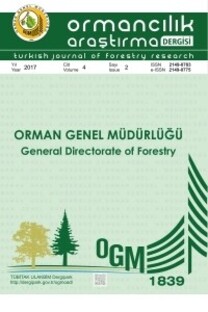Biyogübre uygulamasının Cupressus arizonica ve Acer saccharum L. fidanlarının bazı morfolojik özelliklerine etkisi
Biyogübre, Cupressus arizonica, Acer saccharum, morfolojik özellikler
Effect of biogranulation on some morphological characteristics of Cupressus arizonica and Acer saccharum L. seedlings
___
- Alori, E.T., Dare, M, O., Babalola, O.O., 2017. Microbial Inoculants for soil quality and plant health. Sustainable Agriculture Reviews 22: 281-307.
- Anonim, 2010. Tarımda kullanılan organik, organomineral gübreler ve toprak düzenleyiciler ile mikrobiyal, enzim içerikli ve diğer ürünlerin üretimi, ithalatı ve piyasaya arzına dair yönetmelik. 4 Haziran 2010 tarih ve 27601 sayılı Resmî Gazete.
- Asif, M., Lone, S., Lone, F.A., Hamid, A., 2013. Fıeld performance of blue pıne (pınus wallıchıana) seedlıngs ınoculated wıth selected specıes of bıo-ınoculants under nursery condıtıons. International Journal of Pharma and Bio Sciences 4(1): (B) 632 – 640.
- Benitez, T., Rincon, A.M., Limon, M.C., Codon, A.C., 2004. Biocontrol mechanisms of Trichoderma strains. Int. Microbiology 7: 249–260.
- Berg, G., 2009. Plant-microbe interactions promoting plant growth and health: perspectives for controlled use of microorganisms in agriculture. Applied Microbiology and Biotechnology 84: 11–18.
- Bergottini, V.M., Otegui, M.B., Sosa, D.A., Zapata, P.D., Mulot, M., Rebord, M., Zopfi, J., Wiss, F., Benrey, B., Junier, P., 2015. Bio-inoculation of yerba mate seedlings (Ilex paraguariensis St. Hill.) with native plant growth-promoting rhizobacteria: a sustainable alternative to improve crop yield. Biology and Fertility of Soils 51(6): 749–755.Borkar, S.G., 2015. Microbes as Biofertilizers and Their Production Technology, Woodhead Publishing India Pvt. Ltd., 218 p.
- Contreras-Cornejo, H.A., Macías-Rodríguez, L., Cortés-Penagos, C., López-Bucio, J., 2009 Trichoderma virens a plant beneficial fungus, enhances biomass production and promotes lateral root growth through an auxin-dependent mechanism in Arabidopsis. Plant Physioogyl 49: 1579–1592.
- Deshmukh, A.M., Khobragade, R.M., Dixit, P.P.,2007. Handbook of Biofertilizers and Biopesticides. Oxford Book Company 267, 10-B-Scheme, Opp. Narayan Niwas, Gopalpura By Pass Road, Jaipur-302018 ,326 p.
- Enebak, S.A., Wei, G., and Kloepper, J.W., 1998. Effects of Plant Growth-Promoting Rhizobacteria on Loblolly and Slash Pine Seedlings, Forest Science 44, No. 1, p 139-144.
- Hasrat, A., 2006. Agro Technology of Organic Farming. Published by: Grassroots Instıtute c/o Grassroots India Trust 1st Floor, 134, Street 17, Zakir Nagar, Okhla, Opp. New Friends Colony A-Block, New Delhi – 110 025, 21 p.
- Karthıkeyan, A., and Suryaprakash, M., 2008. Effects of arbuscular mycorrhızal fungı,Phosphobacterıum and Azospırıllum Sp.on the successful establıshment of Eucalyptus Camaldulensıs Dehn. in bauxıte mıne spoils. Forests and Trees and Livelihoods 18 (2): 183-191.
- Kuppurajendran, 2012. Effects of bioinoculants on seedling growth, biochemical changes and nutrient uptake of Erythrina ındica L. ın semi arid region of Southern India. Biometrics & Biostatistics 3:2, DOI: 10.4172/2155-6180.1000134.
- Malusá, E., Sas-Paszt, L., Ciesielska, J., 2012. Technologies for beneficial micro-organisms inocula used as biofertilizers. The Scientific World Journal [Online]. Available: http://www.ncbi.nlm.nih.gov/pmc/articles/PMC3324119/ doi:10.1100/2012/491206 (accessed on 09.09.17).
- Mohan, E., Rajendran, K., 2014. Effect of Plant growth-promoting Microorganisms on Quality Seedling Production of Feronia elephantum (Corr.) in Semi-Arid Region of Southern India. International Journal of Current Microbiology and Applied Sciences 3(7) 103-116.
- Owen, D., Williams, A.P., Griffith, G.W., Withers, P.J.A., 2015. Use of commercial bio-inoculants to increase agricultural production through improved phosphorus acquisition. Applied Soil Ecology 86: 41–54.Parlak S., Güner, D., 2017. Mikrobiyal gübre uygulamasının karaçam (Pinus nigra Arnold. subsp. pallasiana (Lamb.) Holmboe) fidanlarının bazı morfolojik özelliklerine etkisi. Ormancılık Araştırma Dergisi, A, 4:2, 100-106, DOI: http://dx.doi.org/10.17568/ogmoad.337884.
- Paroha, S., Chandra, K.K., Tiwari, K.P., 2000. Synergistic role of VAM and Azotobacter ınoculation on growth and biomass production in forestry species. Journal of Tropical Forestry 16(1): 13-21.
- Raj, A.J,. Nair, S.G., Lal, S.B, Wani, A.M., 2010. Applıcatıon Of Bıo-Fertılızers For Qualıty Seedlıng Productıon Of Teak (Tectona Grandıs), Agricultural Science Digest 30 (4) : 246 – 249.
- Rajeshkumar, S., Chandran Nisha, M., Chidambaram Prabu P., Wondimu, L., Selvara, T., 2009. Interaction between Glomus geosporum, Azotobacter chroococcum, and Bacillus coagulans and their Influence on growth and nutrition of Melia azedarach L. Turkısh Journal of Bıology 33: 109-114.
- Reddy CA, Janarthanam L 2014. Polymicrobial formulations for enhancing plant productivity. US Patent n. US8822190B2.
- Reedy, P.P., 2014. Plant Growth Promoting Rhizobacteria for Horticultural Crop Protection. ISBN 978-81-322-1973-6 (eBook), Springer New Delhi Heidelberg New York Dordrecht London, 313 p.
- Scheffer- Schachtschabel 1970. Lehrbuch der Bodenkunde. Ferdinand Enke Vedrlag – Stuttgart – Fed. Almanya.
- Shishido M., and Chanway C.P., 2000. Colonization and growth promotion of out planted spruce seedlings pre-inoculated with plant growth promoting rhizobacteria in the greenhouse. Canadian Journal of Forest Research 30(6): 845–854.
- Siddiqui, Z. A. 2006. PGPR: Prospective biocontrol agents of plant pathogens. In PGPR: Biocontrol and biofertilization, ed. Z. A. Siddiqui, 111–42. Dordrecht, The Netherlands: Springer.
- SPSS v.22.0, 2015. SPSS 22.0 Guide to Data Analysis, published by Prentice Hall, Upper Saddle River, New Jersey, USA. 637 pp.
- Sreedhar, S.S., and Mohan V., 2016. Effect of different plant growth promoting microbes as bio-Inoculants on the growth improvement of Ailanthus excelsa seedlings in nursery. The İndian Foresters 142 (7): 631-641.
- Sreedhar, S.S., and Mohan V., 2016. Effect of Different Plant Growth Promoting Microbes as Bio-Inoculants on the Growth Improvement of Ailanthus excelsaSeedlings in Nursery, The İndian Foresters Volume 142, Issue 7
- Sumana, D.A. and Bagyaraj, D.J. 2002. Interaction between VAM fungus and nitrogen fixing bacteria and their influence on growth and nutrition of neem (Azadirachta indica A. Juss). Indian Journal of Microbiology 42(4): 295-298.
- ISSN: 2149-0783
- Yayın Aralığı: Yılda 2 Sayı
- Başlangıç: 2014
- Yayıncı: ahu peruzhan ÖZYAKUP
Güz zeytini (Elaeagnus umbellata Thunb.)’nin sert çelikle üretilmesinde bazı oksinlerin etkileri
ALİ BAYRAKTAR, NEBAHAT YILDIRIM, FAHRETTİN ATAR, İBRAHİM TURNA
Türkiye ormancılığı için alternatif örgütlenme modellerinin geliştirilmesi
MURAT KÖSE, İSMET DAŞDEMİR, SEÇİL YURDAKUL EROL, HASAN TEZCAN YILDIRIM, Avni ARSLAN, Emre GÖKSU, Emre GÖKSU, Umut Ahmet ŞEKERCAN, Süleyman ALKAN
Dağ kekiği (Origanum syriacum L. var. bevanii (Holmes) Ietswaart)’nin mikroçoğaltımı
A. Haluk TÜRKER, RÜŞTÜ HATİPOĞLU
Kazım Karabekir Paşa: Kurtuluş Savaşı’nı ormanlar sayesinde kazandık
Nanoteknoloji ve Geleceğin Çevreci Polimeri Nanoselüloz
SALİH PARLAK, MUSTAFA YILMAZ, Orkun ÖZGÜN
Kabuk ve ambrosya böceklerine karşı alternatif mücadele olarak entomopatojen fungusların kullanımı
